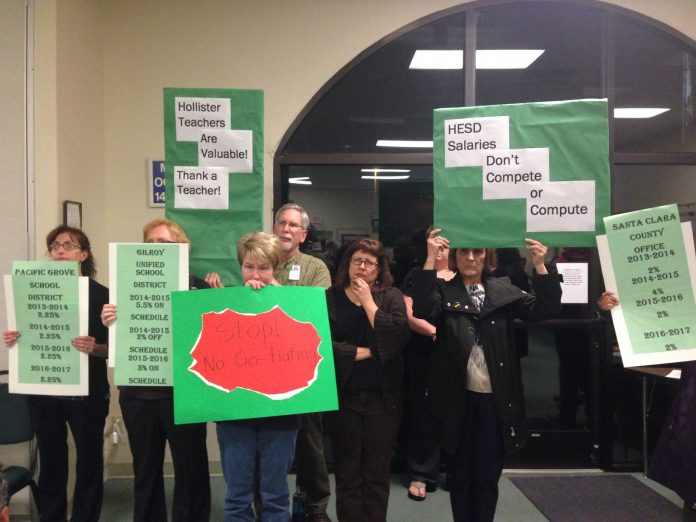At least 20 people stood in the Hollister School District meeting room Feb. 24 and waved bright green, red and yellow signs asking for more pay with such phrases as:
“Stop No Go-tiating”
“Teachers make all other professions possible”
“Teachers give 100% every day—and get 0% raise?”
The Hollister Elementary School Teachers Association is requesting a 4 percent raise for the 2014-15 year,which follows a 2 percent raise in the 2013-14 year. The district is pushing back with an offer of 0 percent for the current school year and is citing lack of funds caused by 34 new hires, an increase in technology, mandated higher contributions to the state pension program for teachers and a desire to get district reserves to 5-6 percent by 2016-17.
For the 2015-16 school year, the association is asking for another 4 percent hike, while the district is offering a 3 percent increase with contingencies based on state funding.
The district’s reserve currently sits at $5.52 million or 11 percent of the budget, according to Kathy Cunnane, the director of fiscal services. But for each 1 percent increase given to the teachers association, reserves drop by 1.42 percent, said district Superintendent Gary McIntire.
“They’re relatively high right now, but we’re deficit spending,” McIntire said. “We’re spending more than we’re getting.”
The two groups met Wednesday to continue negotiations, but an agreement was not reached before press time. The cost to the district of a 1 percent increase to teachers’ salaries would be $228,549, McIntire said. That doesn’t include the costs of making similar increases with the district’s classified bargaining unit having its own conversations with the district, or increases to management compensation, he said.
Among the signs held high at the regularly scheduled meeting Feb. 24 were those listing pay increases at districts in Santa Clara, Monterey and San Benito counties, such as at the Gilroy Unified School District and San Benito High School District.
Speakers who took to the podium during the meeting’s public comment period cited a shortage of people going into the teaching profession and asked the district to boost salaries so it could attract and retain the best candidates.
Just 27 miles southwest in the neighboring North Monterey County Unified School District, teachers received a 5.85 percent raise and other additional benefits as well as two additional workdays as part of their contract agreement for the 2014-15 year, according to the district’s collective bargaining agreement approved in May 2014.
But comparing the two districts may not be fair since the state’s new funding formula awards money based on an “unduplicated count” of students, according Craig Chavez, the district’s assistant superintendent of human resources.
The state’s supplemental and concentration grant amounts are calculated based on the percentage of students who are counted once, if they fit one or more of three categories: English learners, foster youth or receivers of free or reduced price meals. This extra money must be used specifically to help these groups.
“Saying you’re in the same vicinity is no longer a good measure,” Chavez said. “You have to have similar student populations and makeup to even compare apples to apples.”
Different types of school districts also receive varied funding amounts, with high school districts capturing the most funding, elementary institutions capturing the least and unified school districts—including North Monterey County Unified School District—somewhere in the middle.
This funding difference makes it hard to compare the Hollister School District with the San Benito High School District even though the districts have campuses in the same city.
“They’re a high school so they get more funds,” McIntire said. “It’s really an apples to oranges or an apples to bananas comparison.”
McIntire also pointed to some of the factors eating away at the district’s current budget.
Other factors
In the 2013-14 year, the district contributed toward the California State Teachers’ Retirement System pensions at a rate of 8.25 percent but that has been increased by the state to 8.88 percent this school year. The change will cost the district about $122,000 more, McIntire said. The district contributions to the pension program will grow to more than twice that number—or 19.1 percent—in the 2020-21 school year.
The district has also restored its number of class days from 175 days in 2012-13 to 186 days in 2014-15, a decision that comes with an almost $929,000 price tag, McIntire explained.
“All of that costs a lot of money… It’s not like you can put all that back and give people a big 3 or 9 or 10 percent raise,” McIntire said. “I don’t know how other districts are doing this. They probably did not have to make the cuts we had.”
The district has also added technology equipment, with 1,000 Chromebooks for students over two school years along with a Chromebook or new computer for each teacher, McIntire said.
As for personnel, the district added 34 full-time equivalent positions including elementary school physical education teachers, which pulls away classes of students so teachers can collaborate or work with pupils that need extra intervention, McIntire said.
Projections suggest the district won’t get the higher reserves that are the goal for a few years, he said.
“We’re trying to build everything back in that was cut,” McIntire said.










